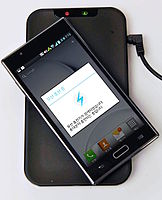
Photo from wikipedia
Dynamic wireless charging for electric vehicles is an emerging technology to provide an alternative solution for onboard battery reduction and driving range extension. Because of their unique characteristic of very… Click to show full abstract
Dynamic wireless charging for electric vehicles is an emerging technology to provide an alternative solution for onboard battery reduction and driving range extension. Because of their unique characteristic of very short charging times and relatively high power levels, high-power dynamic wireless charging systems (DWCSs) introduce significant challenges to grid integration. In this paper, a comprehensive study of the high-power DWCS on grid integration control and impact analysis into distribution networks is conducted. Due to the unique load profile of DWCSs with power pulsations and the inherent imbalanced situations of a distribution network, a control strategy based on direct power control is proposed for the grid interface of DWCS to enhance the load transient response and ensure the stable operation. Considering that the load profile of DWCSs closely relates to traffic volumes and the approaching vehicle speeds, a 24-h load profile is developed based on Annual Average Daily Traffic (AADT) data and a stochastic model to analyze the grid impact of high-power DWCSs in a distribution network. Case studies on a modified IEEE 13-bus distribution network are presented to validate the effectiveness of the proposed approach.
Journal Title: IEEE Access
Year Published: 2021
Link to full text (if available)
Share on Social Media: Sign Up to like & get
recommendations!